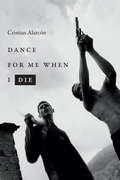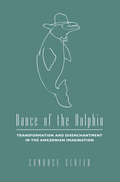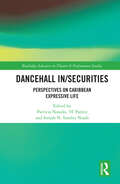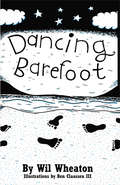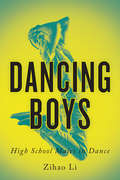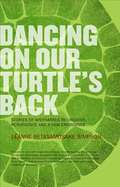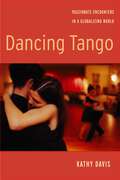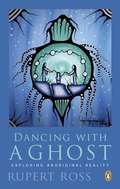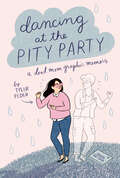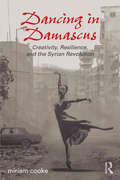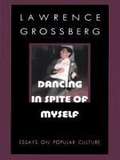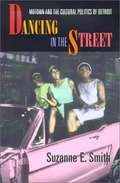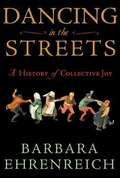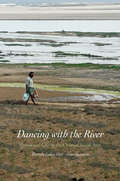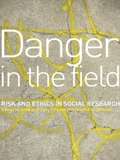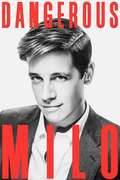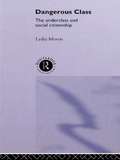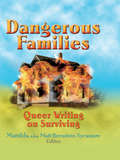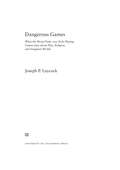- Table View
- List View
Dance for Me When I Die (Latin America in Translation)
by Cristian AlarcónOn the morning of February 6, 1999, Buenos Aires police officers shot and killed seventeen-year-old Víctor Manuel Vital, better known as Frente, while he was unarmed, hiding under a table, and trying to surrender. Widely known and respected throughout Buenos Aires's shantytowns for his success as a thief, commitment to a code of honor, and generosity to his community, Frente became a Robin Hood--style legend who, in death, was believed to have the power to make bullets swerve and save gang members from shrapnel. In Dance for Me When I Die—first published in Argentina in 2004 and appearing here in English for the first time—Cristian Alarcón tells the story and legacy of Frente's life and death in the context of the everyday experiences of love and survival, murder and addiction, and crime and courage of those living in the slums. Drawing on interviews with Frente's friends, family, and ex-girlfriends, as well as with local thieves and drug dealers, and having immersed himself in Frente's neighborhood for eighteen months, Alarcón captures the world of the urban poor in all of its complexity and humanity.
Dance of Disruption and Creation: Epochal Change and the Opportunity for Enterprise
by Nandu Nandkishore Neeraj ChandraIt’s an exciting time to be alive! We are witness to an epoch of change, a dance of disruption and creation, that is re-imagining our world. Where are these disruptions coming from? What opportunities do they uncover? How can one make sense of them? And most importantly, how should one prepare and act? This book, written by two influential business leaders, unpacks these "epochal" changes and how they represent a defining moment of opportunity for the world of business. Nandu Nandkishore and Neeraj Chandra draw upon diverse sources, academic literature, discussions with CEOs, startup founders and experts, in order to understand the significant pivots of change emerging from a wide canvas and then stitch together a perspective of an exciting, brave new world. Unlike many other books that focus only on emerging technologies, the authors here look at disruption through several lenses: technology, demographics, economic change, the changing nature of institutions, and the interplay of technology as it fundamentally shapes consumers and society. The book goes beyond describing changes taking place. It explores the "why so" and "so what" to provide an understanding of the shifts taking place, and crucially, the implications for the world of enterprise. Using simple examples and frameworks throughout, the book provides specific, action-oriented solutions that businesses can employ. This book will be of specific interest to business leaders, strategists, investment professionals, as well as social scientists and public servants. It is for change-makers who are excited to seize the unique opportunity that this change represents – to build competitive advantage, re-invent markets and enterprise, and indeed, to make the world a better place. A selection of reference links and material for the book is accessible at www.routledge.com/9781032184791.
Dance of the Dolphin: Transformation and Disenchantment in the Amazonian Imagination
by Candace Slater<p>In folktales told throughout much of the Brazilian Amazon, dolphins take human form, attend raucous dances and festivals, seduce men and women, and carry them away to a city beneath the river. They are encantados, or Enchanted Beings, capable of provoking death or madness, but also called upon to help shamanic healers. Male dolphins—accomplished dancers who appear dressed in dapper straw hats, white suits, and with shiny black shoes—reportedly father numerous children. The females are said to lure away solitary fishermen. Both sinister and charming, these characters resist definition and thus domination; greedy and lascivious outsiders, they are increasingly symbolic of a distinctly Amazonian culture politically, socially, economically, and environmentally under seige. <p>Candace Slater examines these stories in Dance of the Dolphin, both as folk narratives and as representations of culture and conflict in Amazonia. Her engaging study discusses the tales from the viewpoints of genre, performance, and gender, but centers on them as responses to the great changes sweeping the Amazon today. According to Slater, these surprisingly widespread tales reflect Amazonians' own mixed reactions to the ongoing destruction of the rainforest and the resulting transformations in the social as well as physical landscape. Offering an informed view of Brazilian culture, this book crosses the boundaries of folklore, literature, anthropology, and Latin American studies. It is one of the very few studies to offer an overview of the changes taking place in Amazonia through the eyes of ordinary people.</p>
Dancehall In/Securities: Perspectives on Caribbean Expressive Life (Routledge Advances in Theatre & Performance Studies)
by Patricia Noxolo ‘h’ Patten Sonjah N. Stanley NiaahThis book focuses on how in/security works in and through Jamaican dancehall, and on the insights that Jamaican dancehall offers for the global study of in/security. This collection draws together a multi-disciplinary range of key scholars in in/security and dancehall. Scholars from the University of the West Indies' Institute of Caribbean Studies and Reggae Studies Unit, as well as independent dancehall and dance practitioners from Kingston, and writers from the UK, US and continental Europe offer their differently situated perspectives on dancehall, its histories, spatial patterning, professional status and aesthetics. The study brings together critical security studies with dancehall studies and will be of great interest to students, scholars and practitioners in theatre, dance and performance studies, sociology, cultural geography, anthropology, postcolonial studies, diaspora studies, musicology and gender studies.
Dancing Barefoot
by Wil WheatonWil Wheaton--blogger, geek, and Star Trek: The Next Generation's Wesley Crusher--gives us five short-but-true tales of life in the so-called Space Age in Dancing Barefoot. With a true geek's unflinching honesty, Wil examines life, love, the web, and the absurdities of Hollywood in these compelling autobiographical narratives. Based on pieces first published in Wil's hugely popular blog, www.wilwheaton.net, the stories in Dancing Barefoot chronicle a teen TV star's journey to maturity and self-acceptance. Far from the usual celebrity tell-all, Dancing Barefoot is a vivid account of one man's version of that universal story, the search for self. If you've ever fallen in love, wondered what goes on behind the scenes at a Star Trek convention, or thought hard about the meaning of life, you'll find a kindred soul in the pages of Dancing Barefoot. In the process of uncovering his true geeky self, Wil Wheaton speaks to the inner geek in all of us. The stories: Houses in Motion - Memories fill the emptiness left within a childhood home, and saying goodbye brings them to life. Ready Or Not Here I Come - A game of hide-n-seek with the kids works as a time machine, taking Wil on a tour of the hiding and seeking of years gone by. Inferno - Two 15-year-olds pass in the night leaving behind pleasant memories and a perfumed Car Wars Deluxe Edition Box Set. We Close Our Eyes - A few beautiful moments spent dancing in the rain. The Saga of SpongeBob VegasPants - A story of love, hate, laughter and the acceptance of all things Trek.
Dancing Boys: High School Males in Dance
by Zihao LiThe challenges that young women go through in order to be successful in the world of dance are well known. However, little is known about the experiences of young men who choose to take dance classes in non-professional settings. Dancing Boys is one of the first scholarly works to demystify the largely unknown challenges of adolescent males in dance. Through an ethnographic study of sixty-two adolescent male students, Zihao Li captures the authentic stories and experiences of boys participating in dance classes in a public high school in Toronto. Accompanied by the boys' artwork and photographs and supported by a documentary-style video, the study explores their motivations for dancing, their reflections on masculinity and gender, and the internal and external factors that impact their decisions to continue to dance professionally or in informal settings. With the author's reflections on his own journey as a professional dancer woven throughout, Dancing Boys will spark discussion on how and why educators can engage adolescent males in dance.
Dancing On Our Turtle's Back: Stories of Nishnaabeg Re-creation, Resurgence, and a New Emergence
by Leanne SimpsonMany promote Reconciliation as a "new" way for Canada to relate to Indigenous Peoples. In Dancing on Our Turtle's Back: Stories of Nishnaabeg Re-Creation, Resurgence, and a New Emergence activist, editor, and educator Leanne Simpson asserts reconciliation must be grounded in political resurgence and must support the regeneration of Indigenous languages, oral cultures, and traditions of governance. Simpson explores philosophies and pathways of regeneration, resurgence, and a new emergence through the Nishnaabeg language, Creation Stories, walks with Elders and children, celebrations and protests, and meditations on these experiences. She stresses the importance of illuminating Indigenous intellectual traditions to transform their relationship to the Canadian state. Challenging and original, Dancing on Our Turtle's Back provides a valuable new perspective on the struggles of Indigenous Peoples.
Dancing Tango: Passionate Encounters in a Globalizing World
by Kathy DavisArgentinean tango is a global phenomenon. Since its origin among immigrants from the slums of Buenos Aires and Montevideo, it has crossed and re-crossed many borders.Yet, never before has tango been danced by so many people and in so many different places as today. Argentinean tango is more than a specific music and style of dancing. It is also a cultural imaginary which embodies intense passion, hyper-heterosexuality, and dangerous exoticism.In the wake of its latest revival, tango has become both a cultural symbol of Argentinean national identity and a transnational cultural space in which a modest, yet growing number of dancers from different parts of the globe meet on the dance floor.Through interviews and ethnographical research in Amsterdam and Buenos Aires, Kathy Davis shows why a dance from another era and another place appeals to men and women from different parts of the world and what happens to them as they become caught up in the tango salon culture. She shows how they negotiate the ambivalences, contradictions, and hierarchies of gender, sexuality, and global relations of power between North and South inwhich Argentinean tango is—and has always been—embroiled.Davis also explores her uneasiness about her own passion for a dance which—when seen through the lens of contemporary critical feminist and postcolonial theories—seems, at best, odd, and, at worst, disreputable and even a bit shameful. She uses the disjuncture between the incorrect pleasures and complicated politics of dancing tango as a resource for exploring the workings of passion as experience, as performance, and as cultural discourse. She concludes that dancing tango should be viewed less as a love/hate embrace with colonial overtones than a passionate encounter across many different borders between dancers who share a desire for difference and a taste of the ‘elsewhere.’ Dancing Tango is a vivid, intriguing account of an important global cultural phenomenon.
Dancing With A Ghost: Exploring Aboriginal Reality
by Rupert RossAs a Crown Attorney working with First Nations in remote northwestern Ontario, Rupert Ross learned that he was routinely misinterpreting the behaviour of Aboriginal victims, witnesses, and offenders, both in and out of court. He discovered that he regularly drew wrong conclusions when he encountered witnesses who wouldn't make eye contact, victims who wouldn't testify in the presence of the accused, and parents who showed great reluctance to interfere in their children's offending behaviour. With the assistance of Aboriginal teachers, he began to see that behind such behaviour lay a complex web of coherent cultural commandments that he had never suspected, much less understood. As his awareness of traditional Native teachings grew, he found that the areas of miscommunication extended well beyond the courtroom, causing cross-cultural misunderstanding--and ill-informed condemnation. Dancing with a Ghost is Ross's attempt to give some definition to the cultural gap that bedevils the relationships and distorts the communications between Native peoples and the dominant white Canadian society--and to encourage others to begin their own respectful cross-cultural explorations. As Ross discovered, traditional perspectives have a great deal to offer modern-day Canada, not only in the context of justice but also in terms of the broader concepts of peaceful social organization and personal fulfilment.
Dancing at the Pity Party
by Tyler FederPart poignant cancer memoir and part humorous reflection on a motherless life, this debut graphic novel is extraordinarily comforting and engaging.From before her mother's first oncology appointment through the stages of her cancer to the funeral, sitting shiva, and afterward, when she must try to make sense of her life as a motherless daughter, Tyler Feder tells her story in this graphic novel that is full of piercing--but also often funny--details. She shares the important post-death firsts, such as celebrating holidays without her mom, the utter despair of cleaning out her mom's closet, ending old traditions and starting new ones, and the sting of having the "I've got to tell Mom about this" instinct and not being able to act on it. This memoir, bracingly candid and sweetly humorous, is for anyone struggling with loss who just wants someone to get it.
Dancing in Damascus: Creativity, Resilience, and the Syrian Revolution
by miriam cookeOn March 17, 2011, many Syrians rose up against the authoritarian Asad regime that had ruled them with an iron fist for forty years. Initial successes were quickly quashed, and the revolution seemed to devolve into a civil war pitting the government against its citizens and extremist mercenaries. As of late 2015, almost 300,000 Syrians have been killed and over half of a total population of 23 million forced out of their homes. Nine million are internally displaced and over four million are wandering the world, many on foot or in leaky boats. Countless numbers have been disappeared. These shocking statistics and the unstoppable violence notwithstanding, the revolution goes on. The story of the attempted crushing of the revolution is known. Less well covered has been the role of artists and intellectuals in representing to the world and to their people the resilience of revolutionary resistance and defiance. How is it possible that artists, filmmakers and writers have not been cowed into numbed silence but are becoming more and more creative? How can we make sense of their insistence that despite the apocalypse engulfing the country their revolution is ongoing and that their works participate in its persistence? With smartphones, pens, voices and brushes, these artists registered their determination to keep the idea of the revolution alive. Dancing in Damascus traces the first four years of the Syrian revolution and the activists’ creative responses to physical and emotional violence.
Dancing in Spite of Myself: Essays on Popular Culture
by Lawrence GrossbergIn Dancing in Spite of Myself, Lawrence Grossberg--well known as a pioneering figure in cultural studies--has collected essays written over the past twenty years that have also established him as one of the leading theorists of popular culture and, specifically, of rock music. Grossberg offers an original and sophisticated view of the growing power of popular culture and its increasing inseparability from contemporary structures of economic and political power and from our everyday lives.In the course of conducting this exploration into the meaning of "popularity," he investigates the nature of fandom, the social effects of rock music and youth culture, and the possibilities for understanding the history of popular texts and practices. Describing what he calls "the postmodernity of everyday life," Grossberg offers important insights into the relation of pop music to issues of postmodernity and inton the growing power of the new cultural conservatism and its relationship to "the popular." Exploring the limits of existing theories of hegemony in cultural studies, Grossberg reveals the ways in which popular culture is being mobilized in the service of economic and political struggles. In articulating his own critical practice, Grossberg surveys and challenges some of the major assumptions of popular culture studies, including notions of domination and resistance, mainstream and marginality, and authenticity and incorporation.Dancing in Spite of Myself provides an introduction to contemporary theories of popular culture and a clear statement of relationships among theories of the nature of rock music, postmodernity, and conservative hegemony.
Dancing in the Glory of Monsters
by Jason StearnsAt the heart of Africa is Congo, a country the size of Western Europe, bordering nine other nations, that since 1996 has been wracked by a brutal and unstaunchable war in which millions have died. And yet, despite its epic proportions, it has received little sustained media attention. In this deeply reported book, Jason Stearns vividly tells the story of this misunderstood conflict through the experiences of those who engineered and perpetrated it. He depicts village pastors who survived massacres, the child soldier assassin of President Kabila, a female Hutu activist who relives the hunting and methodical extermination of fellow refugees, and key architects of the war that became as great a disaster as--and was a direct consequence of--the genocide in neighboring Rwanda. Through their stories, he tries to understand why such mass violence made sense, and why stability has been so elusive. Through their voices, and an astonishing wealth of knowledge and research, Stearns chronicles the political, social, and moral decay of the Congolese State.
Dancing in the Rain: Leading with Compassion, Vitality, and Mindfulness in Education
by Jerome T. MurphyDancing in the Rain offers a lively and accessible guide aimed at helping education leaders thrive under pressure by developing the inner strengths of mindfulness and self-compassion, expressing emotions wisely, and maintaining a clear focus on the values that matter most. Jerome T. Murphy, a scholar and former dean who has written and taught about the inner life of education leaders, argues that the main barrier to thriving as leaders is not the outside pressures we face, but how we respond to them inside our minds and hearts. In this concise volume, Murphy draws on a combination of Eastern contemplative traditions and Western psychology, as well as his own experience and research in the field of education leadership. He presents a series of exercises and activities to help educators take discomfort more in stride, savor the joys and satisfactions of leadership work, and thrive as effective leaders guided by heartfelt values. Every day, education leaders find themselves swamped in a maelstrom of pressures that add to the complex challenges of educating all students to a high level. With humor and compassion, Dancing in the Rain shows educators how to lead lives of consequence and purpose in the face of life&’s inescapable downpours.
Dancing in the Street: Motown and the Cultural Politics of Detroit
by Suzanne E. SmithDetroit in the 1960s was a city with a pulse: people were marching in step with Martin Luther King, Jr., dancing in the street with Martha and the Vandellas, and facing off with city police. Through it all, Motown provided the beat. This book tells the story of Motown--as both musical style and entrepreneurial phenomenon--and of its intrinsic relationship to the politics and culture of Motor Town, USA. <p><p>As Suzanne Smith traces the evolution of Motown from a small record company firmly rooted in Detroit's black community to an international music industry giant, she gives us a clear look at cultural politics at the grassroots level. Here we see Motown's music not as the mere soundtrack for its historical moment but as an active agent in the politics of the time. In this story, Motown Records had a distinct role to play in the city's black community as that community articulated and promoted its own social, cultural, and political agendas. Smith shows how these local agendas, which reflected the unique concerns of African Americans living in the urban North, both responded to and reconfigured the national civil rights campaign. <p><p>Against a background of events on the national scene--featuring Martin Luther King, Jr., Langston Hughes, Nat King Cole, and Malcolm X--Dancing in the Street presents a vivid picture of the civil rights movement in Detroit, with Motown at its heart. This is a lively and vital history. It's peopled with a host of major and minor figures in black politics, culture, and the arts, and full of the passions of a momentous era. It offers a critical new perspective on the role of popular culture in the process of political change.
Dancing in the Streets: A History of Collective Joy
by Barbara EhrenreichFrom the bestselling social commentator and cultural historian, a fascinating exploration of one of humanity's oldest traditions: the celebration of communal joy. In the acclaimed Blood Rites, Barbara Ehrenreich delved into the origins of our species' attraction to war. Here, she explores the opposite impulse, one that has been so effectively suppressed that we lack even a term for it: the desire for collective joy, historically expressed in ecstatic revels of feasting, costuming, and dancing. Ehrenreich uncovers the origins of communal celebration in human biology and culture. Although sixteenth-century Europeans viewed mass festivities as foreign and "savage," Ehrenreich shows that they were indigenous to the West, from the ancient Greeks' worship of Dionysus to the medieval practice of Christianity as a "danced religion." Ultimately, church officials drove the festivities into the streets, the prelude to widespread reformation: Protestants criminalized carnival, Wahhabist Muslims battled ecstatic Sufism, European colonizers wiped out native dance rites. The elites' fear that such gatherings would undermine social hierarchies was justified: the festive tradition inspired French revolutionary crowds and uprisings from the Caribbean to the American plains. Yet outbreaks of group revelry persist, as Ehrenreich shows, pointing to the 1960s rock-and-roll rebellion and the more recent "carnivalization" of sports. Original, exhilarating, and deeply optimistic,Dancing in the Streets concludes that we are innately social beings, impelled to share our joy and therefore able to envision, even create, a more peaceable future.
Dancing with the River
by Kuntala Lahiri-Dutt Gopa SamantaWith this book Kuntala Lahiri-Dutt and Gopa Samanta offer an intimate glimpse into the microcosmic world of "hybrid landscapes." Focusing on chars--the part-land, part-water, low-lying sandy masses that exist within the riverbeds in the floodplains of lower Bengal--the authors show how, both as real-life examples and as metaphors, chars straddle the conventional categories of land and water, and how people who live on them fluctuate between legitimacy and illegitimacy. The result, a study of human habitation in the nebulous space between land and water, charts a new way of thinking about land, people, and people's ways of life.
Danger in the Field: Ethics and Risk in Social Research
by Geraldine Lee-Treweek Stephanie LinkogleThe nature of qualitative inquiry means that researchers constantly have to deal with the unexpected, and all too often this means coping with the presence of danger or risk. This innovative and lively analysis of danger in various qualitative research settings is drawn from researchers' reflexive accounts of their own encounters with 'danger'. An original take on the ever-popular topic of the ethics of research, this pioneering book expands the common sense use of the term to encompass not just physical danger, but emotional, ethical and professional danger too, with the authors paying special attention to the gendered forms of danger implicit in the research process. From the physical danger of researching the night club 'bouncer' scene to the ethical dangers of participant observation in an old people's home, these international contributions provide researchers and students with thought provoking insights into the importance of a well chosen research design.
Dangerous
by Milo YiannopoulosThe liberal media machine did everything they could to keep this book out of your hands. Now, finally, Dangerous, the most controversial book of the decade, is tearing down safe spaces everywhere.
Dangerous Classes: The Underclass and Social Citizenship (Male Orders Ser.)
by Lydia MorrisFirst published in 2002. Routledge is an imprint of Taylor & Francis, an informa company.
Dangerous Families: Queer Writing on Surviving
by Matt Bernstein SycamoreQueer survivors piece together the clues to discover their own lives! Dangerous Families: Queer Writing on Surviving goes beyond the recovery narrative to create a new queer literature of investigation, exploration, and transformation. Twenty-six stories illuminate the reality of growing up in fear, struggling to rebuild lives damaged by sexual, physical, and/or emotional abuse. The book explores how abuse turns queer survivors-male, female, and transgendered-into healers, heartbreakers, and homicidal maniacs, presenting brilliant stories that sear and soar. Dangerous Families: Queer Writing on Surviving addresses all forms of abuse head-on, representing a cross-section of queer survivors in terms of race, class, ethnicity, education, origin, sexuality, and gender. Contributors use their own life experiences to create a book that takes back control from well-meaning "outsiders," as they recount the daily struggle to overcome the damage done to their minds, bodies, and spirits in a world that denies their gender, sexual, and social identities. From the editor: "Dangerous Families consists entirely of writing by survivors of childhood abuse. That's right-no therapists analyzing our plight, no talk-show hosts exploiting us-just survivors, exploring our complicated, frightening, and fulfilling lives. These stories dispense with the usual technique of carefully massaging the reader's fragile worldview before plunging this unsuspecting innocent into a world of horror. They go right to the horror, the beauty, and the joy, often throwing the reader off-guard, revealing layers of meaning before the reader can step back." Dangerous Families: Queer Writing on Surviving is an anthology of 26 true stories of growing up queer in families that magnify the horrors of the outside world instead of offering protection. The book is an essential read for therapists, caseworkers, cultural studies specialists, and anyone struggling to survive childhood abuse.
Dangerous Fun: The Social Lives of Big Wave Surfers
by Ugo CorteA thrilling ethnography of big wave surfing in Hawaii that explores the sociology of fun. Straight from the beaches of Hawaii comes an exciting new ethnography of a community of big-wave surfers. Oahu’s Waimea Bay attracts the world’s best big wave surfers—men and women who come to test their physical strength, courage, style, knowledge of the water, and love of the ocean. Sociologist Ugo Corte sees their fun as the outcome of social interaction within a community. Both as participant and observer, he examines how mentors, novices, and peers interact to create episodes of collective fun in a dangerous setting; how they push one another’s limits, nourish a lifestyle, advance the sport and, in some cases, make a living based on their passion for the sport. In Dangerous Fun, Corte traces how surfers earn and maintain a reputation within the field, and how, as innovations are introduced, and as they progress, establish themselves and age, they modify their strategies for maximizing performance and limiting chances of failure. Corte argues that fun is a social phenomenon, a pathway to solidarity rooted in the delight in actualizing the self within a social world. It is a form of group cohesion achieved through shared participation in risky interactions with uncertain outcomes. Ultimately, Corte provides an understanding of collective effervescence, emotional energy, and the interaction rituals leading to fateful moments—moments of decision that, once made, transform one’s self-concept irrevocably.
Dangerous Fun: The Social Lives of Big Wave Surfers
by Ugo CorteA thrilling ethnography of big wave surfing in Hawaii that explores the sociology of fun. Straight from the beaches of Hawaii comes an exciting new ethnography of a community of big-wave surfers. Oahu’s Waimea Bay attracts the world’s best big wave surfers—men and women who come to test their physical strength, courage, style, knowledge of the water, and love of the ocean. Sociologist Ugo Corte sees their fun as the outcome of social interaction within a community. Both as participant and observer, he examines how mentors, novices, and peers interact to create episodes of collective fun in a dangerous setting; how they push one another’s limits, nourish a lifestyle, advance the sport and, in some cases, make a living based on their passion for the sport. In Dangerous Fun, Corte traces how surfers earn and maintain a reputation within the field, and how, as innovations are introduced, and as they progress, establish themselves and age, they modify their strategies for maximizing performance and limiting chances of failure. Corte argues that fun is a social phenomenon, a pathway to solidarity rooted in the delight in actualizing the self within a social world. It is a form of group cohesion achieved through shared participation in risky interactions with uncertain outcomes. Ultimately, Corte provides an understanding of collective effervescence, emotional energy, and the interaction rituals leading to fateful moments—moments of decision that, once made, transform one’s self-concept irrevocably.
Dangerous Fun: The Social Lives of Big Wave Surfers
by Ugo CorteA thrilling ethnography of big wave surfing in Hawaii that explores the sociology of fun. Straight from the beaches of Hawaii comes an exciting new ethnography of a community of big-wave surfers. Oahu’s Waimea Bay attracts the world’s best big wave surfers—men and women who come to test their physical strength, courage, style, knowledge of the water, and love of the ocean. Sociologist Ugo Corte sees their fun as the outcome of social interaction within a community. Both as participant and observer, he examines how mentors, novices, and peers interact to create episodes of collective fun in a dangerous setting; how they push one another’s limits, nourish a lifestyle, advance the sport and, in some cases, make a living based on their passion for the sport. In Dangerous Fun, Corte traces how surfers earn and maintain a reputation within the field, and how, as innovations are introduced, and as they progress, establish themselves and age, they modify their strategies for maximizing performance and limiting chances of failure. Corte argues that fun is a social phenomenon, a pathway to solidarity rooted in the delight in actualizing the self within a social world. It is a form of group cohesion achieved through shared participation in risky interactions with uncertain outcomes. Ultimately, Corte provides an understanding of collective effervescence, emotional energy, and the interaction rituals leading to fateful moments—moments of decision that, once made, transform one’s self-concept irrevocably.
Dangerous Games: What the Moral Panic over Role-Playing Games Says about Play, Religion, and Imagined Worlds
by Joseph P. LaycockThe 1980s saw the peak of a moral panic over fantasy role-playing games such as "Dungeons and Dragons. " A coalition of moral entrepreneurs that included the Christian Right, psychologists, and law enforcement claimed these games were not only psychologically dangerous but an occult religion masquerading as a game. "Dangerous Games" explores both the history and the sociological significance of this panic. Fantasy role-playing games do share several functions in common with religion. However, religion as a socially constructed world of shared meaning can also be compared to a fantasy role-playing game. In fact, the claims of the moral entrepreneurs, in which they presented themselves as heroes battling a dark conspiracy, often resembled the very games of imagination that they condemned as evil. By attacking the imagination, they preserved the taken-for-granted status of their own socially constructed reality. Interpreted in this way, the panic over fantasy-role playing games yields new insights about how humans play and together construct and maintain meaningful worlds. Laycock s clear and accessible writing ensures "Dangerous Games" will be required reading for those with an interest in religion, popular culture, and social behavior, in the classroom and beyond. "
